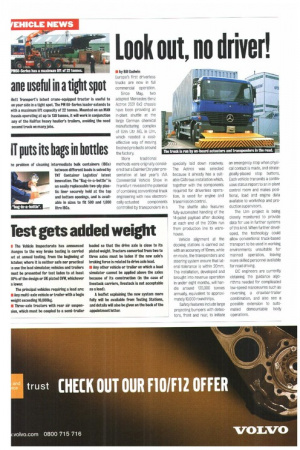Look out, no driver!
Page 13

If you've noticed an error in this article please click here to report it so we can fix it.
• by Bill Godwin Europe's first driverless trucks are now in full commercial operation.
Since May, two adapted Mercedes-Benz Actros 2531 6x2 chassis have been providing an in-plant .shuttle at the large German chemical manufacturing complex of Uzin Litz AG, in Ulm, which needed a costeffective way of moving finished products around the factory.
More traditional methods were originally considered but a DaimlerChrysler presentation at last year's IAA Commercial Vehicle Show in Frankfurt revealed the potential of combining conventional truck engineering with new electroni cally-actuated components controlled by transponders in a specially laid down roadway. The Actros was selected because it already has a suitable CAN-bus installation which, together with the components required for driverless operation, is used for engine and transmission control.
The shuttle also features fully-automated handling of the 14-pallet payload after docking at each end of the 200m run from production line to warehouse.
Vehicle alignment at the docking stations is carried out with an accuracy of 10mm, while en route, the transponders and steering system ensure that lateral tolerance is within 20mm. The installation, developed and brought into revenue operation in under eight months, will handle around 120,000 tonnes annually, equivalent to approximately 10,000 round trips.
Safety features include large projecting bumpers with detectors, front and rear, to initiate
an emergency stop when physical contact is made, and strategically-placed stop buttons. Each vehicle transmits a continuous status report to an in-plant control room and makes positional, load and engine data available to workshop and production supervisors.
The Ulm project is being closely monitored to provide data for use in further systems of this kind. When further developed, the technology could allow conventional truck-based transport to be used in working environments unsuitable for manned operation, leaving more skilled personnel available for road driving.
DC engineers are currently obtaining the guidance algorithms needed for complicated low-speed manoeuvres such as reversing a drawbar-trailer combination, and also see a possible extension to automated demountable body operations.














































































































